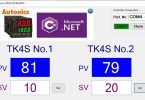1. What is Fiber Optic Sensor?
Fiber optic sensor is a type of sensor composed of 1 amplifier and 1 fiber. This fiber is optionally different depending on the application used. There are two types of optical fibers: transceivers and diffusers.

2. Features of optical fiber sensor
- Compact size, lightweight
- Can be easily integrated into a wide range of structures including composite materials …
- Do not conduct electricity
- No interference from electromagnetic waves and radio frequency interference
- Highly resistant to harsh environments
- High sensitivity
- Able to form a sensor network
- Good remote sensing capability and resistant to pressure, corrosion, temperature and audio signals.

3. Structure and operation principle of optical fiber sensor
3.1 Structure of fiber optic sensors
+ Amplifiers: include a light source, a bounce light processor, and an operating interface to set sensor activity and output signals to other processing equipment.
+ Optical fiber: directs light from the amplifier to the object and directs light back to the amplifier for processing.
+ Fiber Optic Head: means to guide and ensure the optical fiber is installed firmly mechanically. Optionally, the lens can be fitted with extra lenses, to shape the light ray when leaving the fiber or change the receiving angle of the reflected light.
3.2 The working principle of fiber optic sensor
Fiber optic sensors use the principle of total reflection to guide the light source along the fiber to help detect objects. The light traveling inside the fiber is like a stream of water moving from one end to the other reflecting the inner wall to detect objects and this move takes very little brightness so the accuracy is very high.

4. When to use fiber optic sensors instead of photoelectric sensors?
- When the object to be discovered is in a confined space
- When conventional sensors susceptible to damage due to collision
- When it is necessary to detect details of very small objects
- When objects move fast
- When the environment is not friendly – Noise, High temperature, dirt, chemicals, etc.
5. Application of Fiber optic sensors
With such features, fiber optic sensors are applied a lot in industrial automation such as:
- Industries with objects to be discovered lie in confined space
- Industries that install indoor treatment equipment
- Pharmaceutical industry
- Automotive Assembly Industry









